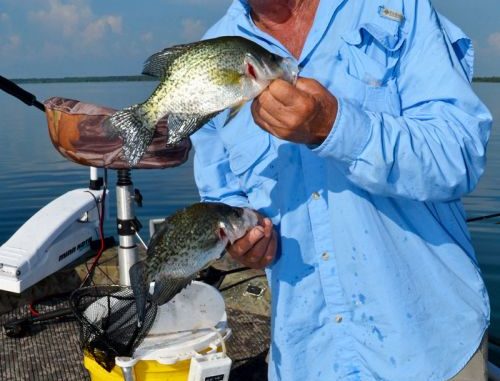
Born and raised in the town of Des Allemands, Tommy Tregle (pronounced Cajun style as “Treg”) has spent almost his entire life making his living from the water.
He began commercial fishing in the ninth grade, mostly catfish at first. A one-year stint working at Avondale shipyards after he got out of school taught him that he didn’t want a “regular job.” So he kept fishing.
In 1970, when he was 19, Uncle Sam came calling with a draft notice. When he returned home, he married Debra Percle, whose family came from Chackbay, and went back to commercial fishing, the only life he knew.
It was, of course, for catfish. Des Allemands had been declared the “Catfish Capital of the Universe” by the Louisiana Legislature. But prices were poor. Wild catfish were difficult to sell in the face of competition from farm-raised catfish.
Prices have remained low, according to Tregle. He cited current prices of 45 to 50 cents per pound, the same prices as were paid right out of high school.
So he gradually shifted more and more effort to crab fishing. Of course, crab prices weren’t so hot either. “They were 8 to 10 cents a pound when we started,” he chuckled.
“One year we got 12 cents. We thought that we were rich. That was the first year Debra and I took a vacation. Last year (2015), number one male crabs got up to $5 a pound.”
Tregle didn’t just crab. He fished monofilament gill nets for shad and mullet in Lake Des Allemands under a special bait permit.
“It was great in crawfish season,” he laughed. I couldn’t catch enough. Then after the season, the shad in the freezers just sat there getting freezer burned. Crabbers don’t like shad for bait like crawfishermen do.”
Mixed in this somewhere, while he was still commercial fishing full time, he built wooden catfish slat traps for sale.
For years, every September, he spent every free moment fishing for alligators with his good friend Dennis Badeaux of Bayou Gauche. “We used to love it, but it got old. The landowner demanded that we skin them, scrape them, and salt them. We couldn’t sell them in the round (uncleaned) like lots of other fishermen.”
Always good with his hands, he built wooden boats in his time off from fishing. In the mid-1970s, he and his brother Jerry decided they wanted aluminum boats, the new thing in the fishing industry. But he didn’t know how to weld aluminum.
No problem.
He watched his brother-in-law Bobby Bergeron weld. With a little experimentation and no further instruction, he built their boats. Then he built more. It seemed that everybody wanted a custom-welded boat.
He built them by the hundreds, sometimes two a week. He used his boat-building earnings to build the modern brick home that he and Debra live in now. “We never had a note on that house,” he exclaimed, almost as if surprised how it happened.
With all of this, he still found time for his hobbies, duck hunting, then later deer hunting and most fascinating of all, collecting sinker cypress logs. He explained.
“Years ago, they had a sawmill in Des Allemands that cut cypress into railroad ties. The logs would be floated to the mill in big rafts. Sometimes they broke loose in the lake, waterlogged, and sank.
“We used to find them while we were trammel netting in the lake for big (20- to 60-pound) blue catfish. We would circle them with the net. If we found them in the same place several times, it meant that there is something there to hold them, like a big log.
“My dad Sidney and I used to raise them from the bottom with logging tongs. My biggest one was 6 feet in diameter.”
The pair built everything from the valuable cypress heartwood: pirogues, paddles, and furniture. Things made of cypress were Sidney’s Christmas gifts to others.
Tommy’s biggest project began in 1991, when he gave up fishing and with his wife, opened a crab factory (a south Louisiana term for a crabmeat picking plant) on the bayou bank across the road from his home.
In keeping with form, he built the state-of-the-art 5,400 square foot facility himself. He and his father even drove the pilings. Because of his aluminum welding skills, he built as much of it of aluminum as possible.
“The Board of Health loved the building,” he smiled. “It had aluminum in places where other factories had wood, like door framing”
Their factory employed 20 to 30 people and at its peak, it used 8,000 to 10,000 pounds of crabs per day. He operated the business until 2011, but by then they were only doing 3,000 pounds a day.
“Production began to drop because older Vietnamese women (whose nimble fingers picked the crabmeat from the shells) began to retire and younger ones didn’t want to do that,” he explained.
“Another factor was the advent of grading. In the early days, all the catch went to the factory (straight run). With grading, 4 grades of crabs were sold: #1 males, #2 males, females, and factory.
“What the factories get to pick now can’t be shipped — junk! Factory crabs can’t produce big lumps and the yield is less.
Tommy Tregle is fully retired now.
“This is what I do,” he said as he dropped a jig next to a cypress tree.
“Funny! When I was fishing for a living, I couldn’t stand sac-a-lait. You couldn’t sell them. When you are catching fish to sell, you don’t want to catch a fish you can’t sell.”
He admits to missing commercial fishing at times, but quickly added that he doesn’t miss having to get up early every morning.
